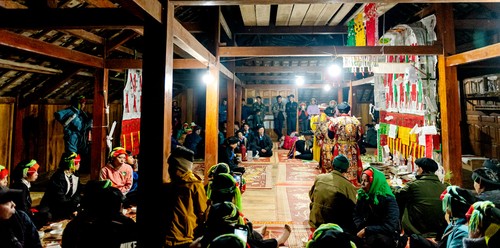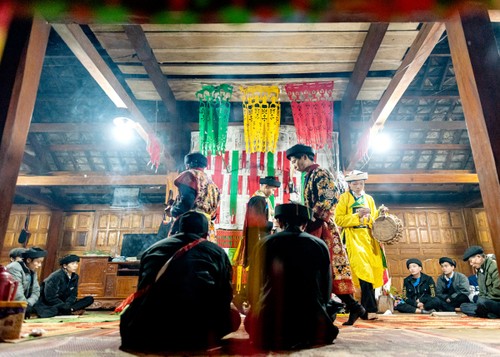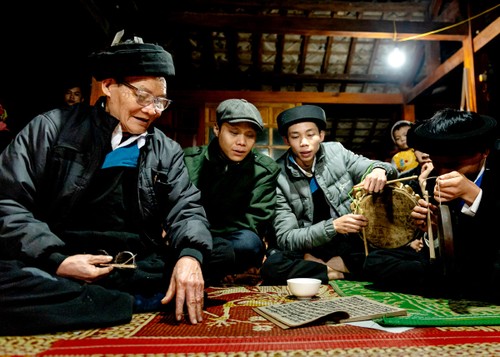 Relatives and villagers gather for a coming-of-age ceremony. (photo: Ha An/ baohagiang.vn) Relatives and villagers gather for a coming-of-age ceremony. (photo: Ha An/ baohagiang.vn) |
A Dao man is only recognized as an adult, a head of a family, and eligible to participate in the community's spiritual and ceremonial activities after undergoing the Cap Sac ceremony. The ceremony is often held in the spring or winter when people seasonally stop farming. It can last from three to seven days, depending on the family's financial conditions and size, and the social status of the person receiving the rite.
Throughout the ceremony, the man must strictly follow ritual rules: reciting prayers, carrying a lantern procession, and receiving the amulet of verification granted by the shaman, which affirms that he is officially recognized as an adult in the Dao community.
Patriarch Ly Dai Thong of Quan Ba district said: “Boys aged 10 to 16 can undergo the Cap Sac ceremony. Even a 40-year-old man, who hasn't participated in this rite of passage, is still considered a child. But at that age, it’s too late to be undergo a ceremony. Our ancestors believe that older people are harder to teach.”
 At about 10 p.m, the Cap Sac ceremony begins. (photo: baohagiang.vn) At about 10 p.m, the Cap Sac ceremony begins. (photo: baohagiang.vn) |
The Cap Sac ceremony is also a time for family reunions when people wear colorful traditional costumes and join in the sacred ceremonial atmosphere with the sound of drums and khen panpipes. It is not only a rite of passage marking a man’s adulthood but also a sacred occasion connecting living people with their ancestors, deities, and the deeper values of their ethnicity.
In a rapidly developing society, many traditional values are at risk of fading. But the Cap Sac ceremony continues to stand out as a symbol of cultural identity, which is untouched by commercialization or dilution because the Dao understand that preserving traditional ceremonies is also preserving their roots.
Patriarch Ly Dai Thong said: “The Cap Sac ceremony is very important to the Dao people. We will never abandon it because it teaches young men to preserve their lineage and invites the ancestors and deities to witness and remind them to do good in life.”
Ly Thanh Phuc who is about to undergo the Cap Sac ceremony, said: “The ceremony holds great meaning. While daughters marry and live with their husband’s family, sons have the duty to carry on the family line. It takes time to prepare well for the ceremony. I’m feeling really nervous.”
 The Cap Sac ceremony takes place overnight. (photo: baohagiang.vn) The Cap Sac ceremony takes place overnight. (photo: baohagiang.vn) |
In Quan Ba district, one of the areas with a large Dao population in Ha Giang, Cap Sac ceremony re-enactments are held regularly as part of cultural-tourism events or community tours. Visitors watch the event and also experience it firsthand by trying on Dao costumes, listening to the shaman’s explanation of the Dao customs, and trying typical dishes served at the Cap Sac ceremony.
Dang Quoc Su, Director of the Ha Giang Provincial Tourism Promotion Center, said: “Ha Giang aims to develop tourism based on cultural and heritage preservation. The Dao's Cap Sac ceremony is one of the province’s most distinctive cultural traditions. Foreign visitors are especially impressed by this coming-of-age ritual.”
If you wish to deeply experience the culture of Vietnam’s ethnic minorities, visit a Dao village in Ha Giang province, where you can take part in a Cap Sac ceremony, and witness the living heritage of the Dao people.